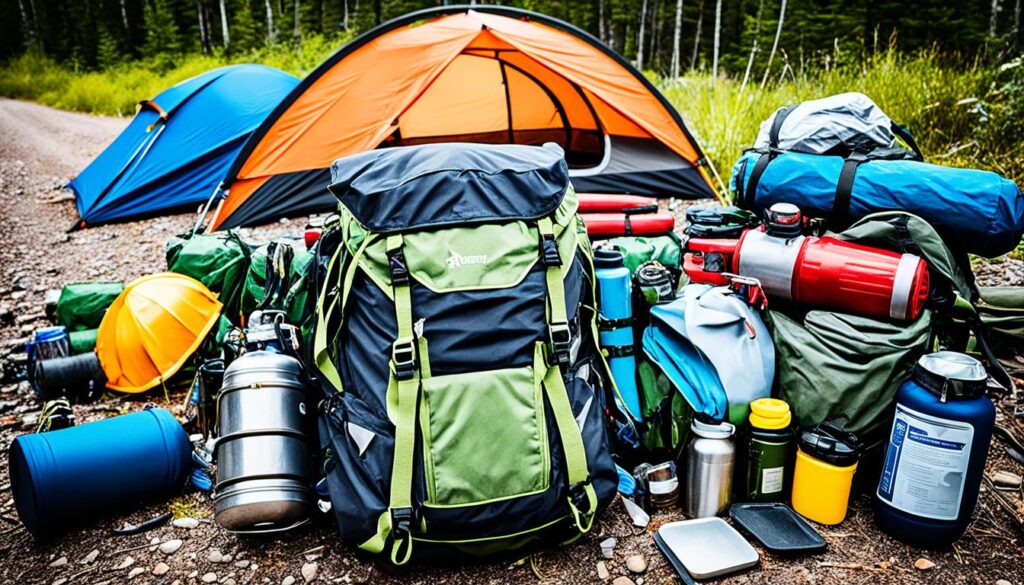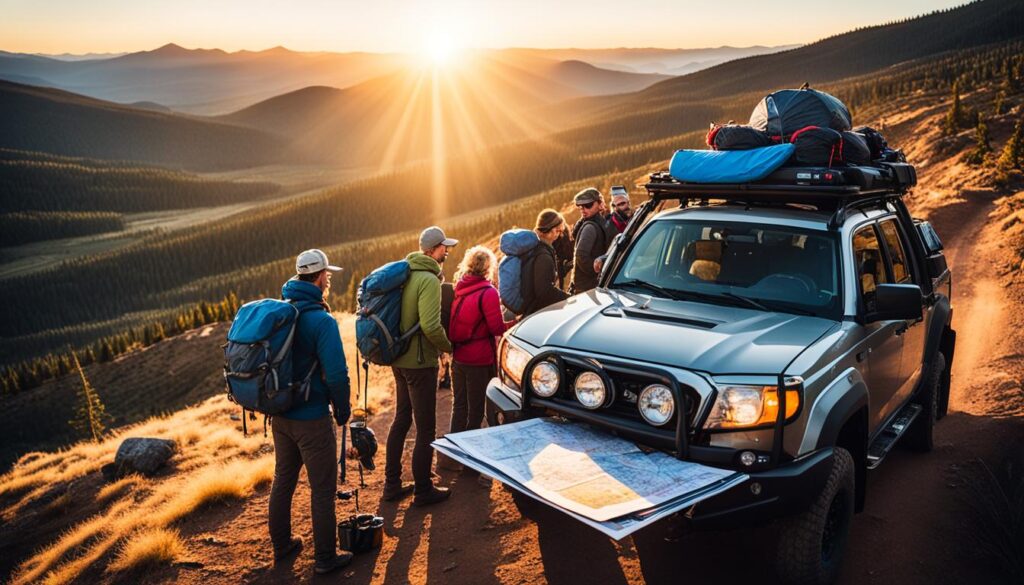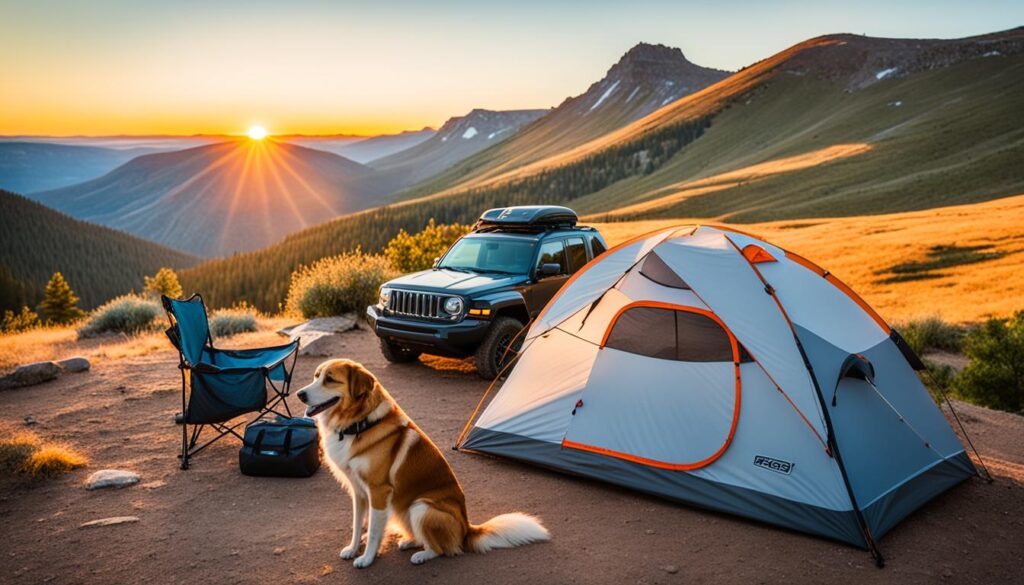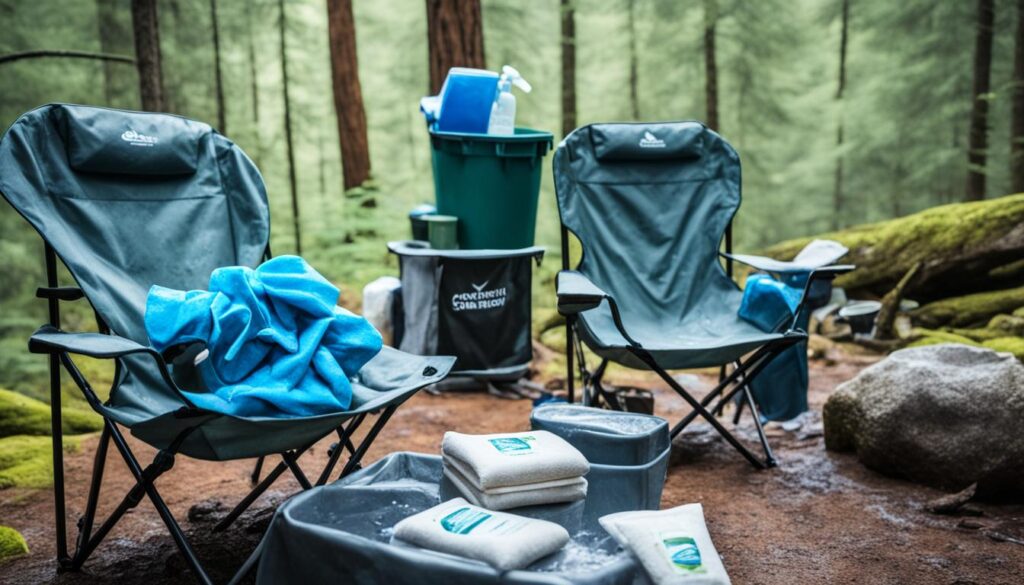Are you ready for an adventure like no other? Have you ever dreamt of exploring remote landscapes, conquering off-road terrains, and immersing yourself in the raw beauty of nature? If so, then overlanding might just be the perfect pursuit for you.
Overlanding has gained immense popularity in recent years, attracting thrill-seekers and nature enthusiasts from all corners of the globe. But how exactly can you get into overlanding? What are the essential tips and gear you need to embark on your own overlanding adventure?
In this comprehensive beginners guide to overlanding, I will provide you with all the necessary information to kickstart your journey as an overlander. From understanding the origins of overlanding to acquiring the best gear and honing your skills, this guide is your roadmap to an unforgettable adventure.
Key Takeaways:
- Discover the origins of overlanding and how it has evolved into a popular form of adventure travel.
- Understand the definition of overlanding and the core principles that drive this thrilling pursuit.
- Gather essential tips and gear to ensure a successful and enjoyable overlanding experience.
- Explore the world of overlanding vehicles and learn about recommended modifications for off-road capability.
- Uncover the best overlanding destinations and routes to satisfy your thirst for exploration.
Contents
What is Overlanding?
Overlanding, in essence, is a form of self-sustained adventure travel that allows individuals to explore remote and untamed areas, immersing themselves in the beauty of nature and the challenges of off-road terrain. Unlike traditional travel, where the destination is the main focus, overlanding prioritizes the journey itself and the experience of being in nature. It is a unique way to reconnect with the outdoors and embark on an adventure that is both thrilling and liberating.
At its core, overlanding is a form of travel that requires preparation, self-sufficiency, and a sense of adventure. It is about venturing off the beaten path, away from crowded tourist destinations, and experiencing the raw beauty and authenticity of the natural world. It is a chance to disconnect from the modern world and embrace a simpler way of life, relying on oneself and the resources at hand.
Overlanding involves traveling in a vehicle, often equipped with camping gear and supplies, to navigate through challenging terrains. Whether it’s a rugged mountain trail, a dusty desert road, or a dense jungle path, the goal is to push boundaries and explore areas that are not easily accessible through conventional means of transportation.
Key Features of Overlanding:
- Self-sufficiency: Overlanding requires individuals to be prepared and self-reliant, as they venture into remote areas with limited amenities and resources. This includes carrying sufficient food, water, fuel, and camping gear to ensure a comfortable journey.
- Off-road Exploration: Overlanding involves traversing off-road terrains that are inaccessible to regular vehicles. This requires vehicles with robust capabilities, such as four-wheel drive, high ground clearance, and advanced suspension systems.
- Connection with Nature: Overlanding enthusiasts embrace the opportunity to immerse themselves in nature and experience its wonders up close. From witnessing breathtaking landscapes to encountering wildlife in their natural habitats, overlanding allows for a deeper appreciation of the natural world.
- Sense of Adventure: Overlanding is not for the faint of heart. It requires a spirit of adventure and a willingness to tackle challenges and uncertainties along the way. From navigating unfamiliar routes to encountering unexpected obstacles, every day brings new experiences and opportunities for personal growth.
Embarking on an overlanding adventure is an opportunity to break free from the confines of everyday life and embrace the freedom and beauty that the great outdoors has to offer. Whether you’re an experienced traveler seeking a new kind of adventure or a nature enthusiast looking to reconnect with the natural world, overlanding provides a unique and fulfilling experience like no other.
| Benefits of Overlanding | Challenges of Overlanding |
|---|---|
| 1. Opportunity to explore remote and untouched areas | 1. Limited access to amenities and services |
| 2. Immersion in nature and the great outdoors | 2. Potential risks and hazards |
| 3. Freedom to create personalized itineraries | 3. Vehicle maintenance and repairs |
| 4. Experiencing a sense of adventure and self-discovery | 4. Navigating unfamiliar routes and terrains |
| 5. Flexibility to change plans and adapt to unforeseen circumstances | 5. Limited access to communication and connectivity |
Getting Started with Overlanding: Essential Tips and Gear
Before embarking on your overlanding adventure, it’s important to be prepared and equipped with the essential gear. Here are some key tips to help you get started:
1. Vehicle Preparation
Ensure your vehicle is in good working order and equipped with safety features. Regularly check the tires, brakes, lights, and fluids to ensure they are in optimal condition. It’s also important to have a reliable spare tire and necessary tools for basic vehicle repairs.
2. Gear Checklist
When it comes to gear, it’s important to pack wisely. Here’s a checklist of essential items:
- A tent and sleeping bag for comfortable camping.
- Appropriate clothing for the weather conditions, including layers for warmth.
- Toiletries and personal hygiene items.
- Food and water provisions for the duration of your trip.
- Items for protection from the elements, such as sunscreen, bug spray, and rain gear.
- Navigation tools, such as maps, a GPS device, or a compass.
- First aid kit and emergency supplies.
3. Researching the Terrain
Before setting off on your overlanding journey, research the terrain and weather conditions of your chosen destination. This will help you better prepare and pack the necessary gear. Be aware of any specific challenges or restrictions you may encounter, such as river crossings or off-road regulations.
“Being well-prepared and having the right gear can make all the difference in ensuring a safe and enjoyable overlanding experience.” – [insert real name]

By following these essential tips and packing the right gear, you’ll be well-prepared to embark on your overlanding adventure. Stay safe, have fun, and enjoy the journey!
Building Your Overlanding Vehicle
When it comes to overlanding, having a reliable and capable vehicle is essential. While any vehicle can be used for overlanding, certain modifications and features can enhance its off-road capability and reliability. These modifications will ensure that your vehicle is ready to conquer the rugged terrain and remote locations that overlanding adventures often entail.
When building your overlanding vehicle, it’s important to consider the recommended vehicles for overlanding. Popular options among experienced overlanders include Toyota 4Runners, Tacomas, Land Cruisers, Jeeps, and trucks from GMC, Dodge, and Ford. These vehicles are known for their durability, off-road capabilities, and reliability, making them excellent choices for overlanding adventures.
Table: Recommended Vehicles for Overlanding
| Brand | Model | Features |
| ———–|—————-|—————————-|
| Toyota | 4Runner | Off-road prowess |
| Toyota | Tacoma | Versatile and reliable |
| Toyota | Land Cruiser | Legendary off-road ability |
| Jeep | Wrangler | Iconic 4×4 capability |
| GMC | Sierra | Rugged and dependable |
| Dodge | Ram | Power and towing capacity |
| Ford | F-150 | All-terrain performance |
Once you have chosen a suitable vehicle, you can optimize it for overlanding by making specific modifications. Some popular modifications include:
- Upgrading tires for better traction and durability in off-road conditions
- Adding recovery gear, such as winches and recovery straps, to help get unstuck in challenging situations
- Improving lighting and navigation systems to enhance visibility and navigation capabilities in remote areas
- Installing roof top tents or other camping accessories to provide comfortable sleeping arrangements
By incorporating these modifications, you can customize your vehicle to meet your specific needs and preferences on the overlanding journey.
Building a reliable overlanding vehicle is a crucial step in preparing for your adventures. It ensures that you have a capable and trustworthy vehicle that can take you to remote destinations and handle the demands of off-road travel. Whether you choose a recommended vehicle or modify your existing one, investing in the right vehicle and modifications will provide peace of mind and enhance your overall overlanding experience.
Choosing Overlanding Destinations and Routes
One of the most exciting aspects of overlanding is the opportunity to explore remote and less-traveled places. With numerous overlanding destinations and routes to choose from, you can tailor your adventure to your preferences and the region you’re in. Here are some popular overlanding destinations:
Moab, Utah
Famous for its breathtaking scenery and access to national parks, Moab is a sought-after destination for overlanders. Its diverse landscape offers a range of off-road trails, from challenging terrains to more leisurely routes.
Mojave Road, California
The Mojave Road is a well-traveled route known for its challenging obstacles and historic significance. Stretching through the Mojave National Preserve, this trail provides a thrilling adventure that tests both your driving skills and your vehicle’s capabilities.
South Core Banks, North Carolina
If beach camping in a remote location is what you seek, South Core Banks in North Carolina is an ideal destination. With picturesque coastal landscapes and limited accessibility, it offers a unique overlanding experience away from the crowds.
Baja, Mexico
Baja is renowned for its stunning beaches and off-road adventures. Whether you’re exploring the rugged terrain of Baja California or cruising along the pristine coastline of the Baja Peninsula, this destination promises unforgettable overlanding experiences.
When choosing your overlanding destinations and routes, it is essential to research and plan ahead. Consider factors such as accessibility, terrain difficulty, and local regulations. Familiarize yourself with the area’s attractions, natural landmarks, and any necessary permits or passes. By carefully selecting your destinations and routes, you can embark on an overlanding journey that allows you to explore remote places and immerse yourself in the beauty of nature.

| Destination | Key Features |
|---|---|
| Moab, Utah | Beautiful scenery, national parks |
| Mojave Road, California | Challenging obstacles, historic significance |
| South Core Banks, North Carolina | Remote beach camping, picturesque coastal landscapes |
| Baja, Mexico | Stunning beaches, off-road adventures |
Essential Skills for Overlanding: Problem Solving, Driving, Camping, and Navigation
Overlanding requires a diverse set of skills to ensure a successful and enjoyable experience. Whether you’re traveling through rugged terrain or navigating unfamiliar roads, honing your overlanding skills is essential. From problem-solving to camping and navigation, here are the key skills that every overlander should possess:
Problem Solving
Problem-solving skills are crucial for overcoming challenges and obstacles that may arise on the road. As an overlander, you’ll encounter various situations that require quick thinking and resourcefulness. From mechanical problems with your vehicle to language barriers in foreign countries, being able to adapt and find solutions is vital. Road closures and unexpected detours are also common, so having the ability to improvise and reroute is essential.
Driving Skills
Driving skills, both on and off-road, are important for navigating different terrains and ensuring vehicle safety. Overlanding often takes you off the beaten path, where you’ll encounter uneven surfaces, steep inclines, and challenging obstacles. It’s crucial to develop techniques for off-road driving, such as maneuvering through mud, sand, and rocks. Additionally, understanding the limits of your vehicle and practicing defensive driving techniques will help keep you safe during your adventures.
Camping Skills
Camping skills involve setting up camp, cooking meals, and managing supplies. When overlanding, you’ll spend nights in remote locations. Knowing how to pitch a tent, choose suitable camping spots, and secure your campsite is essential for a comfortable and safe experience. You’ll also need to be proficient in cooking meals over a campfire or a portable stove and managing your food and water supplies efficiently.
Navigation Skills
Navigation skills are essential for planning routes, reading maps, and using GPS devices. Overlanding often takes you to remote areas where traditional GPS signals may be limited. Being able to read maps and use a compass will help you navigate through unfamiliar territory. Familiarize yourself with GPS devices and offline maps that can assist you in planning routes and tracking your progress while off-grid. It’s important to develop a solid understanding of orienteering and be prepared to navigate using traditional methods if technology fails.
Developing these overlanding skills takes time, practice, and experience. Whether you’re a beginner or a seasoned overlander, continually honing these skills will enhance your ability to adapt to unforeseen circumstances and make the most of your overlanding adventures.
Continue reading to discover the best overlanding destinations and routes to embark on your next adventure.
Conclusion
Overlanding is a thrilling and rewarding way to travel and explore the great outdoors. By following the tips and advice in this guide, beginners can get started on their overlanding journey with confidence. Understanding the basics of overlanding, acquiring the necessary gear and skills, and embracing a spirit of adventure are essential to starting your overlanding adventure.
Throughout the guide, we emphasized the importance of preparation and self-reliance. Researching destinations, planning routes, and creating packing lists can help ensure a smooth and enjoyable overlanding experience. It is crucial to be conservation-minded, respecting the environment and leaving no trace as you explore remote places. This mindful approach allows future generations to enjoy the beauty of nature as well.
As you embark on your overlanding adventure, be open to new experiences and challenges. Overlanding is not just about reaching a destination; it is about immersing yourself in the journey, connecting with nature, and discovering your own capabilities. So pack your gear, prepare your vehicle, and get ready for an unforgettable adventure. Happy overlanding!
FAQ
How do I get started with overlanding?
To get started with overlanding, it is important to research and plan your trip, acquire the necessary gear, and have a reliable vehicle. Start by choosing a destination and determining the route you want to take. Research the terrain and weather conditions to ensure you are prepared. Next, gather essential gear such as a tent, clothing, food, water, and items for vehicle repairs. Finally, make sure your vehicle is in good working order and equipped with any necessary modifications.
What is overlanding?
Overlanding is a form of self-reliant adventure travel that involves traveling on off-road terrain in a vehicle. The goal of overlanding is to experience nature and enjoy the journey, rather than focusing on reaching a specific destination. It originated from early Australian cattle drivers who traveled and lived “over land” with their livestock and has now become popular all over the world.
What gear do I need for overlanding?
Essential gear for overlanding includes a tent, camping gear, clothing, food, water, tools, and equipment for vehicle repairs. It is important to be prepared for any weather and terrain conditions you may encounter on your journey. Additionally, safety features such as a first aid kit, fire extinguisher, and emergency communication devices are recommended.
What vehicles are recommended for overlanding?
Popular vehicles for overlanding include Toyota 4Runners, Tacomas, Land Cruisers, Jeeps, and GMC, Dodge, and Ford trucks. The key is to have a reliable and capable vehicle that suits your preferences and the terrain you will be traveling on. It is also important to have any necessary modifications and upgrades to enhance your vehicle’s off-road capabilities and reliability.
How do I choose overlanding destinations and routes?
When choosing overlanding destinations and routes, consider your preferences and the region you are in. Research popular overlanding destinations, such as Moab, Utah, the Mojave Road in California, South Core Banks in North Carolina, or Baja, Mexico. Consider the accessibility, terrain difficulty, and local regulations of your chosen destination. Plan your route accordingly to ensure a safe and enjoyable journey.
What skills do I need for overlanding?
Overlanding requires a set of skills to ensure a successful and enjoyable experience. Problem-solving skills are crucial for overcoming challenges and obstacles that may arise. Driving skills, both on and off-road, are important for navigating different terrains and ensuring vehicle safety. Camping skills involve setting up camp, cooking meals, and managing supplies. Navigation skills are essential for planning routes and using maps and GPS devices.






